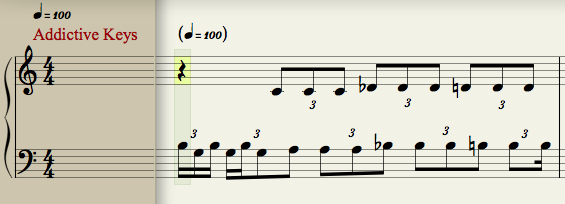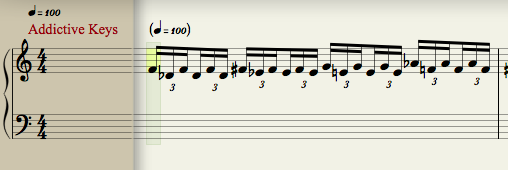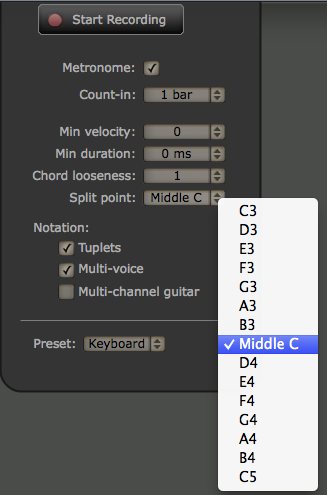SUCCINCT VERSIONI think that if you export MusicXML from Harmony Assistant, then it will work as you desire when you import the MusicXML to NOTION 3 or NOTION 4 . . .
DETAILS AND THOUGHTSI created a simple NOTION score with an Addictive Keys piano part on a single staff; exported it as a MIDI file (*.mid); and then imported the MIDI file, where the the first measure of the original and imported versions are shown as follows:
 Piano Score (BEFORE) -- 1st measure
Piano Score (BEFORE) -- 1st measure Piano Score (AFTER) -- 1st measureTHOUGHTS
Piano Score (AFTER) -- 1st measureTHOUGHTSI am
not so thrilled by the way this works, since I think exporting a section of music notation in MIDI format followed by importing the MIDI file should produce exactly the same result, which I suppose it does, at least with respect to the way it sounds when played, but I think this can be improved, although perhaps not in any practical way, because the most logical solution is to have a function or option to standardize the music notation so that it will be exported and then imported exactly . . .
The drawback to this is that it would change whatever specific formatting and other adjustments were made by the composer, which virtually guarantees it would
not make most folks happy . . .
On the other side of the coin, when the exported and imported version itself is converted to music notation and then exported as a MIDI file, when that MIDI file is imported, it matches exactly, which is encouraging . . .
The key bit of information gleaned from this experiment is that Middle C (C4 in scientific pitch notation) is the "split-point" . . .
I did another experiment, where I switched to NOTION 4 Score Setup and changed the Grand Staff to a Standard Notation Staff, which makes it easier to see what happened . . .
[
NOTE: If you are using Firefox, you can right-click on this image and select "View Image" to see the full image . . . ]
 Piano Score (AFTER) -- 2nd through last measures
Piano Score (AFTER) -- 2nd through last measuresThe key bit of information here is seen in the third measure, which other than not showing the custom tuplets and slur in the three notes before the tied half-note, is correct . . .
I used "6/4" custom tuplets, which probably is non-standard, and I see no problems with NOTION 4 deciding to use standard triplets or whatever . . .
From this experiment, I think that having the ability to specify the "split-point"--as contrasted to it being fixed as Middle C--might be a nice solution . . .
Yet another reality, which is very important to understand, is that a MIDI file does not have any specific formatting information for music notation, other than the names of the notes, so converting MIDI to music notation by definition requires doing extensive analyzing and decision making, and there probably are limitations on the information about music notation that can be made via the various mathematics, geometry, and so forth, where the reality is that MIDI is very precise, but music notation by design is imprecise, where this is the case if only because the duration of notes are powers of two . . .
You can change the notes in music notation via tuplets and other strategies but overall it is imprecise . . .
However, I did yet another experiment, and there is a way to export the music notation and then to import it such that it is replicated exactly, and this is done by exporting the music notation as MusicXML, which works very nicely . . .
[
NOTE: In this experiment, I started with the original NOTION 4 score (see above, first screen capture) and exported it as MusicXML, followed by importing the just created MusicXML file, which created a new NOTION 4 score that is exactly like the original, with the exception of the custom tuplet bars not being shown, which I think is an option or whatever . . . ]
 MusicXML Experiment: Piano Score (AFTER) -- 1st measure
MusicXML Experiment: Piano Score (AFTER) -- 1st measureBased on this result, I did another experiment, where I started by transposing the original music notation upward by a fourth so that all the notes are Middle C or higher. I showed the sequencer overlay and quantized it to the music notation, followed by exporting it as MIDI. Then I imported the MIDI and it matched the original, with the exception that the custom "6/4" tuplets were represented as standard triplets, which is fine with me and qualifies as a
standardized exact match, as shown in the following screen capture . . .
 Quantized Standard MIDI Experiment Transposed to avoid Middle C Split: Piano Score (AFTER) -- 1st measure
Quantized Standard MIDI Experiment Transposed to avoid Middle C Split: Piano Score (AFTER) -- 1st measureI did another experiment, where I imported the NOTION 4 original exported MIDI to Digital Performer 8 (MOTU), where it looks like this in the Digital Performer 8 Notation Editor after I did "Smart Quantize" with the "All" option on it:
[
NOTE: The MIDI file I used was the one created by exporting as MIDI the original NOTION 4 score (the first screen capture above), and it imports to Digital Performer 8 very accurately, with the exception (a) of using standard triplets rather than the custom "6/4" tuplets; (b) of not showing brackets for the tuplets ; and (c) of not showing the slur. . . ]
 Digital Performer 8: Notation Editor ~ Smart Quantize (All) on NOTION 4 Original Score MIDI Export
Digital Performer 8: Notation Editor ~ Smart Quantize (All) on NOTION 4 Original Score MIDI ExportWhen I exported the MIDI from Digital Performer 8 and then imported it to NOTION 4, this is the result, which basically is identical, with the same exceptions of triplets . . .
[
NOTE: I think the key difference is that Digital Performer 8 by default does not use a Grand Staff, hence everything is on a single staff and consequently there is no arbitrary "Split-Point". With the Smart Quantize (All) applied, this effectively smooths the MIDI so that it fits precisely to music notation, which effectively is like mapping real numbers (MIDI) to integers (music notation), hence the resulting music notation is a good match for the original music notation from which MIDI was exported . . . ]
 NOTION 4: Import of Digital Performer 8 MIDI Export ~ Single Staff ~ No "Split-Point"SUMMARY
NOTION 4: Import of Digital Performer 8 MIDI Export ~ Single Staff ~ No "Split-Point"SUMMARY(1) I think that importing and exporting music notation as MIDI will be subject to what one might call "best guess" considerations with respect to using the imported MIDI to recreate the music notation, where in some respects the most significant presumption is the "split-point" arbitrarily being Middle C, but quantizing the sequencer overlay stuff also appears to make a difference . . .
(2) I think that importing and exporting music notation as MusicXML is precise, which when the particular format of the music notation is important makes MusicXML the preferred exporting option, other than copying the music notation to the Clipboard and pasting it into a new NOTION 4 score . . .
(3) It might be nice (a) to be able to specify the "split-point" and (b) to be able to specify that tuplets have visible brackets . . .
(4) Depending on the particular instrument and notes, you can transpose it upward to avoid the arbitrary Middle C "split-point" before exporting as MIDI; and after you import the resulting MIDI, you can transpose downward, where this probably involves exporting the bass clef of a Grand Staff separately from the treble clef of a Grand Staff . . .
(5) Depending on which Digital Audio Workstation (DAW) application you are using, you might be able to use the DAW application to do the conversion to avoid the arbitrary Middle C "split-point" . . .
(6) The NOTION 4 User Guide is
not going to explain all this stuff in detail, so you need to do some experiments, which I think also is the case with the Digital Performer 8 User Guide, except that I never have read it, hence all I can do is guess, since if I cannot discover how to do something in Digital Performer 8, I call MOTU Technical Support, where the first thing they tell me is that I really should read the User Guide, followed by telling me how to solve the problem, which usually takes a minute, and I only call them perhaps a few times every year (no more than five times a year), although beginning with Digital Performer 8, the User Guide is in PDF format, so more recently I have started using it, except that it is 992 pages, which is a
lot of detail . . .
OBSERVATIONOne of the things you discover when you take the time to explore the inner workings and more advanced functionality of NOTION 4 is that it is surprisingly deep and rich in its capabilities . . .
In a sense, going from MIDI to music notation is like going from real numbers to integers, and at best it is likely to be a bit imprecise in one way or another, because some of the information necessary to reproduce music notation exactly either (a) does
not to exist in MIDI data or (b) is extraordinarily difficult to discover via mathematical algorithms, even with significant artificial intelligence enhancements . . .
From a high-level and very practical perspective, I am happy so long as I can find at least one way to do what I want to do using the digital music production software I have here in the sound isolation studio, and in this instance I think I have several ways to do what I want to do, which is fabulous . . .
Fabulous! 








